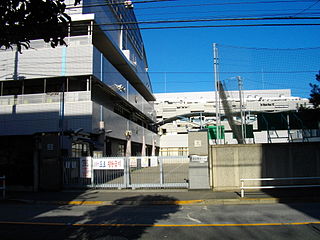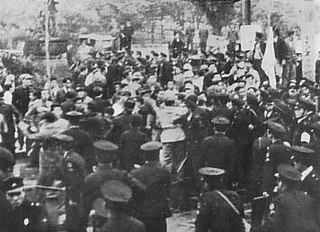You can help expand this article with text translated from the corresponding article in Japanese. (June 2020)Click [show] for important translation instructions.
|
 | |
 | |
| Abbreviation | Mindan |
|---|---|
| Formation | October 3, 1946 |
| Type | NGO |
| Location |
|
Official language | Korean, Japanese |
| Website | www |
- Japan-Korea relations
- Ethnic issues in Japan
- Koreatowns in Japan
- Korean diaspora (a.k.a. 'Dongpo' or 'Gyopo')
- Chongryon, similar organization with close ties to North Korea
- The Federation of Korean Associations, Japan, similar organization meant for post-1945 South Korean immigrants
- Embassy of South Korea, Tokyo
Related Research Articles

Koreans in Japan are ethnic Koreans who immigrated to Japan before 1945 and are citizens or permanent residents of Japan, or who are descendants of those immigrants. They are a group distinct from South Korean nationals who have immigrated to Japan since the end of World War II and the division of Korea.
The Young Koreans Against Ethnic Discrimination in Japan, abbreviated as Mintohren or Mintōren, is a grass-roots movement created by young Koreans in Japan to combat ethnic discrimination by encouraging a multicultural and positive approach to integration of Koreans into Japanese society.

The General Association of Korean Residents in Japan, abbreviated as Chongryon or Chōsen Sōren, is one of two main organisations for Zainichi Koreans, the other being Mindan. It has close ties to North Korea and functions as North Korea's de facto embassy in Japan, as there are no diplomatic relations between the two countries. The organisation is headquartered in Chiyoda, Tokyo, and there are prefectural and regional head offices and branches throughout Japan.

Yakiniku, meaning "grilled meat", is a Japanese term that, in its broadest sense, refers to grilled meat cuisine.
Uyoku dantai refers to Japanese ultranationalist far-right activists, provocateurs, and internet trolls often organized in groups. In 1996 and 2013, the National Police Agency estimated that there were over 1,000 right-wing groups in Japan with about 100,000 members in total.

Shisei Kuwabara is a photojournalist best known for his depiction of the effects of mercury poisoning on people in and near Minamata over a period of some forty years.

Ōtsu is the capital city of Shiga Prefecture, Japan. As of 1 October 2021, the city had an estimated population of 343,991 in 153,458 households and a population density of 740 persons per km2. The total area of the city is 464.51 square kilometres (179.35 sq mi).

Kamameshi is a Japanese rice dish traditionally cooked in an iron pot called a kama. Many varieties exist, but most consist of rice seasoned with soy sauce or mirin, and cooked with meats and vegetables. In modern times, it is often considered a type of takikomi gohan.

So Man-sul was the chairman of the Central Standing Committee of the pro-Pyongyang General Association of Korean Residents in Japan (Chongryon), as well as a member of the Supreme People's Assembly of the Democratic People's Republic of Korea.

Han Duk-su was a North Korean activist who founded the General Association of Korean Residents in Japan (Chongryon) in 1955. His activism started when he moved to Atami in 1933 and advocated for the rights of Zainichi Koreans who were forced to work on the Tanna Tunnel in Japan. However, he was arrested for this a year later, being sentenced to two years in prison.

Zainichi Korean is a variety of Korean as spoken by Zainichi Koreans. The speech is based on the southern dialects of Korean, as the majority of first-generation immigrants came from the southern part of the peninsula, including Gyeonggi-do, Jeolla-do and Jeju-do.
Lee Kyung-jae, also known as I Kyonje, Yi Gyeong-jae, or Yi Kyǒngjae is an ethnic Korean community organiser in Japan.

Kushiro River is a river in Hokkaidō, Japan. It is 154 kilometers (96 mi) in length and has a drainage area of 2,510 square kilometers (970 sq mi). The Kushiro originates from Lake Kussharo and flows south across the Kushiro Plain. The river is joined by two tributaries, the Kuchoro River and the Setsuri River, before it empties into the Pacific Ocean at the port at Kushiro. The lower reaches of the river form broad wetlands. The Shinkushiro River, which was built roughly parallel to the Kushiro River, was completed in 1931 and flows south to the Pacific Ocean.

Zaitokukai, full name Zainichi Tokken o Yurusanai Shimin no Kai, is an ultra-nationalist and far-right extremist political organization in Japan, which calls for an end to state welfare and alleged privileges afforded to Zainichi Koreans. It has been described by the National Police Agency as a potential threat to public order due to its "extreme nationalist and xenophobic" ideology.
Kazuki Kaneshiro is a Zainichi Korean novelist who was born in Kawaguchi, Saitama.

Tokyo Korean School is a Korean school located in Wakamatsu-cho, Shinjuku-ku, Tokyo, Japan; catering to the Korean expatriate community and to Japanese-Koreans living in and around Tokyo. It was founded in 1954. It is affiliated with the South Korean government and Mindan (민단). It includes an elementary school, a middle school and a high school. The total population of the school is some 1,100 students. The primary language of instruction at the school is Korean; but there is an English language department and English library at the school. Japanese is also taught as a second language at the school. Educational essentialism is the main educational philosophy of teachers in both the Korean and English departments at the school.

Chōsen gakkō are North Korean schools in Japan. "Chōsen" means Korean and "gakkō" means school. They are affiliated with the Chongryon (the General Association of Korean Residents in Japan) which has strong ties to North Korea. Sometimes Chōsen gakkō schools are referred to as Chongryon schools.

The Hanshin Education Incident occurred in April 1948, when Japanese authorities, acting under the directions of the Government of the United States and the Japanese Ministry of Education, closed down private Korean ethnic schools operating in Japan. This caused protests across Japan that ranged in size to up to 20,000 civilians. The majority of the protests were concentrated on the streets of Osaka and Kobe, the capital of Hyogo Prefecture, where civilians protested the closure of the Korean schools. Hanshin, the location of many of the demonstrations, is the region that lies between Osaka and Kobe.

The History Museum of J-Koreans is a museum covering the history of Koreans in Japan located in Tokyo, Japan. The museum was established on November 24, 2005.
The Federation of Korean Associations, Japan is an ethnic association for Koreans in Japan. It caters primarily to recent South Korean emigrants. It is headquartered in Shin-Ōkubo, Tokyo, Japan.
References
- 1 2 在日本大韓民国民団 [Mindan]. Nihon Kokugo Daijiten (in Japanese). Tokyo: Shogakukan. 2012. OCLC 56431036. Archived from the original on 2007-08-25. Retrieved 2012-08-05.
- 1 2 在日朝鮮人問題 [Issues of Zainichi Koreans]. Nihon Daihyakka Zensho (Nipponika) (in Japanese). Tokyo: Shogakukan. 2012. OCLC 153301537. Archived from the original on 2007-08-25. Retrieved 2012-08-05.
- 1 2 3 4 Koo, Bon Woo (2022). "Visualization of an Imagined Landscape through Posters: Figurative Elements of Mindan Posters" (PDF). The Journal of the Asian Conference of Design History and Theory. 4: 90–99.
- ↑ 在日本大韓民国民団 [Mindan]. Dijitaru Daijisen (in Japanese). Tokyo: Shogakukan. 2012. OCLC 56431036. Archived from the original on 2007-08-25. Retrieved 2012-08-05.
- 1 2 3 4 5 6 Lim, Youngmi (2 August 2018). "Responding to Hate in Contemporary Japan: Fragmenting Factors Obstructing Effective Ethnic Advocacy". academic.oup.com. Retrieved 2024-03-26.
- 1 2 3 4 5 6 Hamel, Winston (2014). "The Future of Zainichi Korean Socio-Political Organizations in Japan".
- 1 2 3 4 Mauludino, Rizqi Wisnu; Iskandar, Kurniawaty (2022). "South Korean Diaspora in Japan: Suffrage and COVID-19 Issues". The International Journal of East Asian Studies. 11 (1): 51–68 – via ResearchGate.
- ↑ <日대지진> 피난민 "한국 곰탕.김치로 마음달래요" (in Korean). Yonhap News. 2011-04-07.
- ↑ "Mindan Leader Hopes for Removal of Girl Statue Before Japan's Consulate". Yonhap News Agency. 6 Feb 2017. Retrieved 7 Apr 2024.
External links
- MINDAN official website (Korean, Japanese)
- History of Mindan (English)
- Mindan News (Japanese)
- Republic of Korea (ROK) Embassy in Japan (Korean / Japanese)
| Korean Residents Union in Japan | |
|---|---|
 Flag of Mindan |
| International | |
|---|---|
| National | |
| Academics | |